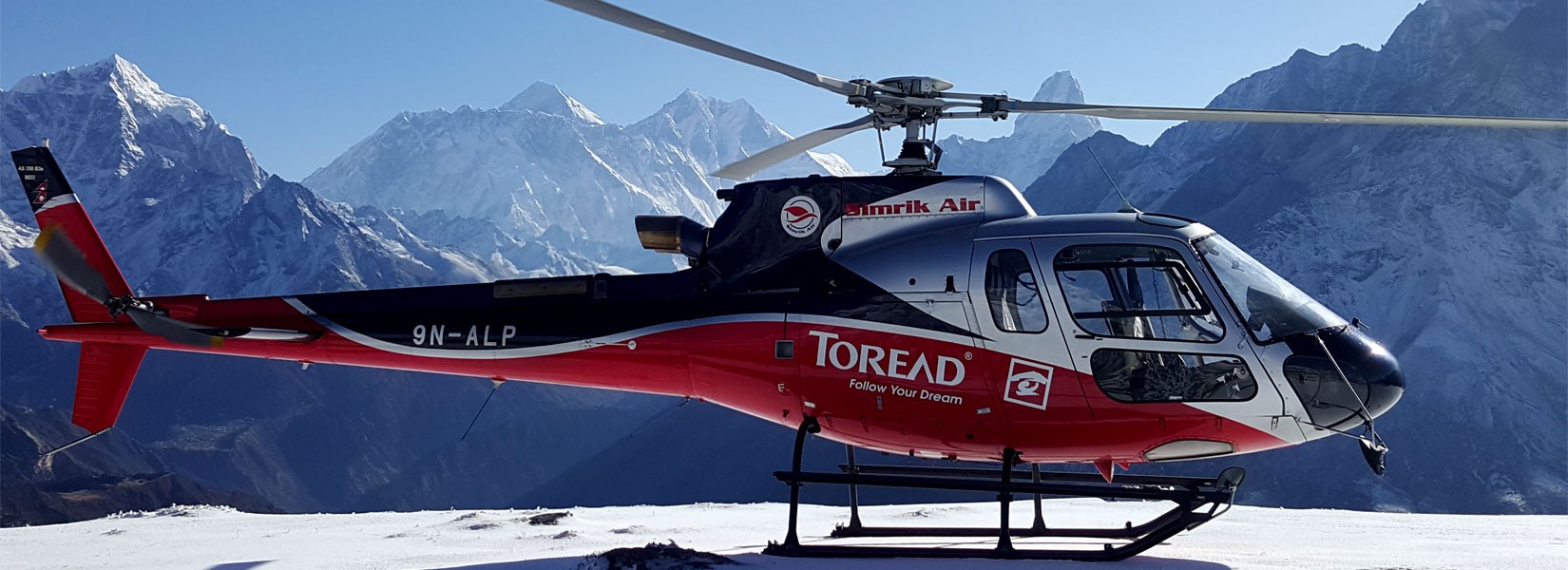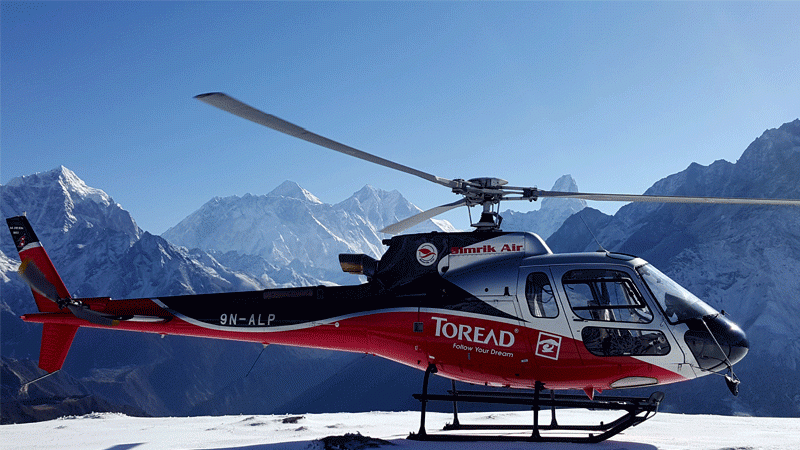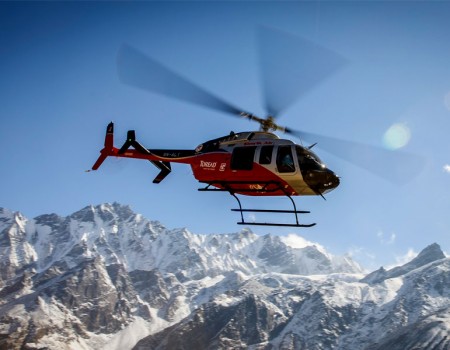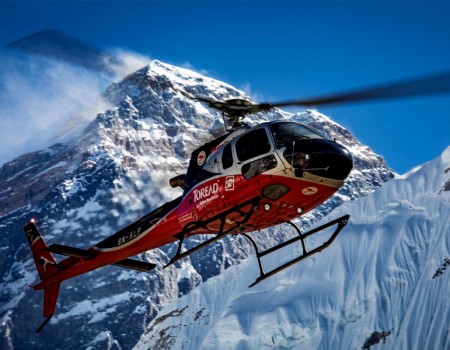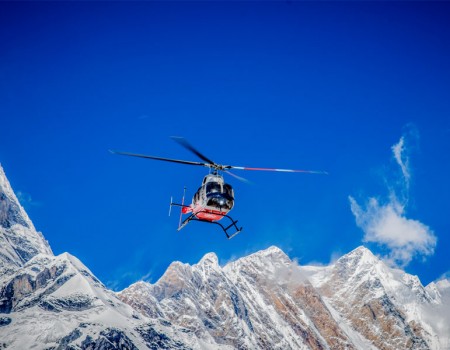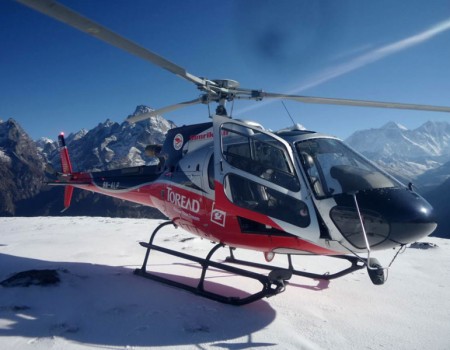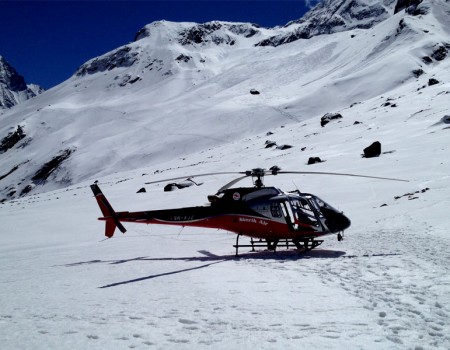Everest base camp helicopter tour with Landing is one of the amazing adventure tours to capture the exceptional view of Mt. Everest and other giant peaks in the comfort of a chopper. Reaching Everest Base Camp normally takes more than 2 weeks (5364 m). The trek to the foot of the highest peak, Mt. Everest, can be exhausting and requires physical fitness. No worries. If you are a non-trekker and have limited time, we can make your dream of getting close to the highest peak of the world come true. Nepal Adventure Team has the best alternative: an EBC Helicopter tour, which will take you around the base camp on a 4/5 hour journey.
The Everest helicopter tour with Landing is a one-day tour that starts from Kathmandu to Lukla. The helicopter flight to base camp normally accommodates 2 people, 3 people, 4 people, and up to 5 people with full window seats. The helicopter stops at the Lukla airstrip for a short moment to prevent any hazardous situation where you can observe the first glimpse of a unique Sherpa culture. The helicopter then flies from Lukla to Everest base camp, observing the beautiful environment beneath you, and lands in Kala Patthar.
Kala Patthar (at 5550m) is an exclusive vantage point to capture the jaw-dropping panorama view of the entire Everest region. The helicopter stops here for 10-15 mins. You can take photos and videos here. After spending a dreamy time in Kala Patthar, the helicopter will fly to the Everest View Hotel where we will have our breakfast, enjoying the beautiful view of nearby villages and landscapes filled with evergreen fir trees, shrubs, and rhododendron forests. After breakfast, we flew back to Kathmandu.
The Everest base camp helicopter flight tour can be the most thrilling lifetime flight experience in Nepal. The scenic helicopter flight provides the best views of high mountains, including the Highest Peak in the world, Gauri Shankar, Mt. Ama Dablam, Mt. Makalu, Cholatse, Nuptse, Pumori, Lhotse, etc. The helicopter flies over the ancient Sherpa villages, monasteries, beautiful landscapes, green alpine forests of rhododendron and pine, and glaciers.
EBC Helicopter Tour Route
Everest Base Camp Helicopter Tour takes the safest route, providing mesmerizing vistas of the Himalayas and the Sherpa Settlement of the Khumbu region. We will pick you up from the hotel early in the morning and drive you to Kathmandu Airport. The helicopter starts flying over the Nagarkot hills and alpine forest and lands at Lukla, the bustling town of trekkers. The helicopter refuels at Lukla and flies over Sherpa villages such as Namche Bazaar, Tengboche Monastery, and Pheriche to Kala Patthar and EBC. The helicopter stops at an altitude of 5,545 m, Kala Patthar, for 10-15 minutes.
You will relish the panoramic vistas of Mt.Everest, Lhotse, Nuptse, Amadablam, and many more. You will witness the closest view of the Mighty Mount Everest from Kala Patthar. You will enjoy a memorable breakfast at Hotel Everest View, savoring the breathtaking view of Mt.Everest.
The Helicopter Trip rides back to Kathmandu from Kathmandu Domestic Airport, and you will be driven back to the hotel.
The Helicopter Tour route offers awe-inspiring vistas of the surrounding hills of Kathmandu valley, the lush green alpine forest, the Sherpa Settlement of the Khumbu region, the Khumbu glacier, and the panoramic vistas of the Mighty Mt. Everest with other towering peaks. The Everest Base Camp Helicopter Tour route offers the closest and most memorable view of Mt. Everest.
Everest Base Camp Helicopter Tour Cost
We offer an Everest Base Camp Helicopter Tour at a very reasonable cost. Everest Base Camp Helicopter Tour cost varies with the size of the group and individual – the number of the pax. Normally, the helicopter accommodates up to 5 people.
Everest Base Camp Helicopter Tour Cost for Private Groups
If you have private groups, we can customize the Everest Base Camp Helicopter Tour cost and itinerary as per your requirements. Whether you want to charter the whole helicopter or you are two or three, we are flexible in organizing the Everest Base Camp Helicopter Tour. The helicopter flight accommodates up to 5 people. Everest Base Camp Helicopter Tour costs for private groups start from $5100.
Everest Base Camp Helicopter Tour Cost in Sharing
We have a daily group departure for the Everest Base Camp Helicopter Tour. If you are a solo trekker and want to share the tour with others in the group then Tour Price will be shared with the group. The service and experience will be the same as on private flights to Everest Base Camp with cost differences.
The Price depends on the services and requirements of the trekkers. We also customized the Ride as per the requirements of the trekkers to enhance their experience of witnessing Mighty Mt. Everest. Normally, Everest Base Camp Helicopter Tour costs start at USD 1450 per person.
Everest Base Camp Helicopter Tour Permit
Mt Everest lies in Sagarmatha National Park. So, to enjoy the Everest Base Camp Helicopter Tour, you need two permits. The first one is the Sagarmatha National Park Entrance Permit. The other one is the Khumbu Pasang Lhamu Rural Municipality Entrance Permit. These two permits are required to enter the Everest region.
These permits will let you enjoy the mesmerizing panoramic vistas of the high Himalayas of Nepal, including Mt. Everest and the beauty of the Everest region like Sherpa Settlements, wild flora, and fauna.
Everest Base Camp Helicopter Tour Weather
The Weather plays a crucial role in operating The Helicopter Tour. The weather in the high mountains and at high altitudes can’t be predicted. The weather changes with no time in the high mountains, so we always check the weather forecast before embarking on the journey to Everest Base Camp Helicopter Tour.
Generally, the Everest Base Camp Helicopter Tour operates in the early morning. It is so because the weather is clear and good in the morning. If the weather is likely to change, the Everest Base Camp Helicopter Tour will be postponed for the next day without any additional charges.
The weather can vary at different times of the year and different altitudes, generally colder temperatures at high altitudes. Everest Helicopter Tour Weather will be cold and windy, so it’s important to prepare and dress appropriately for such weather conditions. Make sure you wear windproof clothes while landing at Kala Patthar and Everest Base Camp.
Different Options Available for EBC Heli Tour Package
Lukla to Everest Base Camp Helicopter Excursion with Landing Price.
The heli tour from Lukla to EBC is an attractive aerial tour that lets tourists travel in a helicopter along Phakding, Namche, and other appealing sites in the north of Namche to EBC. Similarly, this trek is a natural feast of mountain giants, including Nuptse, Lhotse, Pumori, Lobuche, Amadablam, and Sherpa settlements and glacial lakes. The incredible moment is a stop at Kalapatthar Point to view the mountain range and Mount Everest, which is 5,644 meters above sea level. It ends with the flight again to Lukla, or if the beginning of the trek was at Phakding, then it goes back to Phakding. Again, the cost differs depending on the service provider. Still, the expedition is an incredible chance to marvel at the sheer environment of the Everest region while sparing the body the rigors of trekking.
A helicopter journey from Phakding to Everest Base Camp, landing at Kalapathar base, then continuing to Kathmandu.
The Everest Base Camp tour, starting in Phakding and sightseeing by helicopter, is one of the most thrilling and adventurous tours, selling breathtaking views of the Huge Himalayas. It also involves covering large stretches and terrains that are either steep, at elevated altitudes, or both, and the landscape is typically characterized by snowy mountains and rocky cliffs, suitable for thrilling themes. Compared to the previous trek going through Lukla Airport, which was quite a difficult experience, the tour arrives at EBC, where the guests can view the peak at ground level. The next captured part will take them to Kalapathar, which is over 5,500 meters, facilitating the best view of Mount Everest and other giants. Even if the accommodation provided by the temporary Mount Everest View hotel is quite primitive, there are splendid backdrops for shooting. As part of the final itinerary, the passengers are flown back to Kathmandu after they are done with the spectacular views of the mountains in the region.
Departure from Namche to EBC or Kalapathar base for close-up views of Mt. Everest, then return to Lukla or Kathmandu by Helicopter.
Teahouse trekking from Namche Bazaar to Everest Base Camp and Kalapathar is an unforgettable journey for enthusiastic trekkers who love to discover Mount Everest's hillocks and tough nature. The Kalapathar is a bit higher than the base camp, yet very close to the mighty Everest mountainous height; thus, it is always majestic and very humbling to be there. Suppose travelers wish to explore the beauty of Everest for a while before leaving. In that case, they can take a helicopter ride back to Lukla or Kathmandu, making the journey shorter. It is a helicopter adventure that offers trekkers an easy way to get down after going for a high-altitude trek and, at the same time, offers an opportunity to enjoy the difficult terrains undertaken. Regardless of the choice made for the return journey, one could always get a magnificent round trip through the heart of the Great Himalayas for a lifetime.
From Tengboche at 3,867 meters to Everest Base Camp, landing at Lukla or flying back to Kathmandu via Helicopter.
At an altitude of 3,867 meters, the trip to Tengboche Village and the Gompa attached to it is among the most inspiring views in the entire Himalayas region. Tengboche also offers adventure, and the Everest view and monastery make it an ideal starting point. This journey takes clients through valleys, farming villages, glacier rivers, and switchback trails with peaks looming above. Other things being equal, the warmth and hospitality of the Sherpas surely add a pleasant dimension. Reaching Everest's base camp is a feat on its own, especially if one can view the magnificent Everest and the mighty Khumbu range closely. Some professionals suggest that contacting an isolated Nepali or Tibetan village from EBC through a helicopter with a journey of about 1 hour to Lukla or Kathmandu is one challenging, thrilling adventure. Introducing: For 5 hours, you get to float above the landscape and enjoy a comfortable flight back. Riding a helicopter over the Himalayas thus effectively brings curtains down on the marvels of the adventure.
Helicopter flights from Pheriche and Dingboche to Everest Base Camp or Kalapathar base, then return to Kathmandu.
A helicopter tour from Pheriche or Dingboche to the base camp or Kalapathar is also an interesting way of enjoying the round trip without going on a trekking expedition for several days. I hopped aboard a helicopter at around 5 pm, starting at 14 thousand feet, quickly gliding through the Khumbu Valley and seeing monumental mountains and glacial valleys below. There is a chance to visit EBC or Kalapatthar to witness the sights at ground level, with an extra focus on Mount Everest and surrounding mountains such as Lhotse and Nuptse. The latest segment of the journey includes the return by helicopter up to Kathmandu, which provides one last glimpse of the stunning Himalayan range. This heli tour is one of the most efficient and exciting packages in that it covers the journey from Pheriche and Dingboche to EBC and Kalapathar and onwards to Kathmandu.
Option to depart from Pangboche to Everest Base Camp or Kalapathar Hill, with helicopter service available, and land at Lukla.
Starting from the village of Pangboche, which stands at around 3,985 meters above sea level, the Helicopter tour of the Everest or the Kalapathar Hill is undoubtedly one of the most scenic helicopter tours one can experience, as the area boasts some of the world's most awe-inspiring mountain views. The van climbs up, and when the helicopter starts to lift off, one can see the vast rocky plateau and mountain ranges covered with snow in the distance. There is a possibility to go to the Everest Base Camp or Kalapathar Hill, explore this incredible area, and book a local agency with an incredible view of the Himalayas, including Everest, Lhotse, and Nuptse mountains. I also enjoyed the sense of accomplishment from ascending almost six thousand meters to the famous location known as the Everest Base Camp during the climbing season. Kalapathar Hill is somewhat taller and is one of the best vantage points for viewing the mighty Everest. The trip to Lukla and back in helicopters is a comfortable way to cross the mountains, with an element of danger and adrenaline, and to feel like a true explorer amid the mountains throughout the journey.
Helicopter flight from Thukla to Lobuche to Everest Base Camp, then onward to Lukla or back to Kathmandu.
A helicopter tour to the Everest region starts in the village of Pangboche, around 4600 meters above sea level, and arrives at the Everest Base Camp or Kalapathar Hill. The flight offers a scenic view of the higher Himalayas, including the Everest region, as well as clean and beautiful valleys. Traveling to the Location through the EBC or KHP lets one view the Himalayas range and picturesque environment that may be difficult to explore with other tours. While on an Everest Base Camp trek, other attractions that might be seen along the trails include the incredible Khumbu Ice Fall and the Lhotse and Nuptse mountains. Enjoying already breathtaking views and having photographed most of the highlighted places at the EBC, the helicopter's return to Lukla and Kathmandu adds a luxurious touch to the adventurous holiday in the mountains.
Access helicopter service from Everest Base Camp or nearby areas, with the option to return to Lukla or Kathmandu.
Touring by helicopter from Everest Base Camp or its vicinity can be a fantastic and very efficient way to top off a trekking experience on Mount Everest. It is always thrilling to see the world from a different perspective, and the helicopter ride gives a splendid aerial tour that will make one close one's eyes and make one afraid of the magnificent mountains such as Mount Everest. Helicopters with facilities that allow for high-altitude sequences add a convenient option for returning to Lukla or Kathmandu for any trekker who wishes not to trek back or for anyone wishing to cut down his or her trekking journey. Finally, the flight back offers one last magnificent view of the mountains and a chance to contemplate the trek's goal. While whatever is left to explore the stunning area of Lukla or move on to the bustling city of Kathmandu for some Rr, the service of the helicopters acts as a delightful and effective finale to the treacherous albeit awesome ascent of the spiralling landscape of Mount Everest.
Departure from Gorakshep or nearby Everest Base Camp and Kalapathar base, with a helicopter drop at Lukla or a continuation to Kathmandu.
Everest Village in Nepal can end at Gorakshep, Base camp, or even at Kalapathar – a perfect high for a Himalayan adventure. Gorakshep is a small trekking lodging site located at an altitude of about 5164 meters, which offers the trekkers the lodging as a temporary rest and also a good quitting point for those who want to move to the Kalapathar or the base of Mount Everest. Some people wait for hours to get a tend of this height just to experience a close view of the Himalayas, but with helicopter-assisted trekking, you don't have to trek on the return trip. In-flight, they will give you marvelous views of the Himalayas, Everest, Lhotse, and so many others, giving you the best view you can get of the area. It's a rather different experience, though the helicopter can also drop you off at Lukla- the entrance to Mount Everest- landing as smooth as butter. From Lukla, you can further penetrate the area Ariel, or if time is of the essence, opt for a helicopter ride back to Kathmandu and get a view of the magnificent Himalayan trail that has just been conquered.
Helicopter journey from Lukla to Syangboche or vice versa.
Running either from Lukla to Syangboche or from Syangboche to Lukla gives fascinating bird's eye views of the mountains and hills of the Everest region. The enticing service of a helicopter ride into the challenging and visually stunning airstrip at Lukla is available to trekkers and tourists who want to see the stunning views. If you ever happen to be flying out, you have a good vantage point to view lush green valleys, rice fields, and villages typical of Sherpa settlements. From Lukla, a flight to Syangboche at 3,780m is even more mesmerizing as visitors are treated to a bird's eye view of the ever-prominent Everest View Hotel, which provides a vantage point to view Mount Everest and other mountains. This 45-minute sightseeing helicopter ride can also be an effective and comfortable transport between Lukla and Syangboche. During this time, you can avoid the difficult trekking paths down to the plains. This helicopter tour is popular among tourists as it is convenient, offers stunning views of nature, and is a stylish way to discover the Everest Region.
Pricing details for helicopter travel between Kathmandu and Lukla and vice versa.
Transportation services like the heli-tourists who fly from Kathmandu to Lukla are another form of transport that is efficient and thrilling as one can view some aspects of the Himalayas up close. Hiring a helicopter service that can transport several people from Kathmandu to Lukla or vice versa costs thousands of US dollars, depending on the time of the year, the availability of the helicopters, and the kind of helicopter rental service. With a one-way flight ranging between (PRICE), it is relatively cheaper and can carry about five passengers, which fits well for a few travelers, or you share by paying each. Still, traveling by helicopter is often more expensive than regular airfare; some of the advantages include operating it especially reliably in bad weather, and customers do not have to endure the constant cancellation or staunch base to Lukla of fixed-wing flights. Using helicopters is also more comfortable and results in a more direct journey, thereby giving travelers a fairly good view of the natural beauty of the region around Mount Everest. Regarding the above factors, helicopters have a higher cost for travelers compared to other modes of transport in the Himalayas, but they are advantageous to travelers in terms of ease, reliability, and the adventure of flying over the mountains.
Best Season for Everest Base Camp Helicopter Flight Tour
We operate Everest base camp helicopter flight tours throughout the year. Even though we suggest March, April, May, and September, October, November, and December as the best months to go for the Everest Heli tour. During these months, the sky remains mostly clear, giving the best view of Mt. Everest and its adjoining peaks.
How to Book an Everest Base Camp Helicopter Flight Tour?
Whether you are in a group or you are on your own, we are available all the time to assist you with your Everest base camp helicopter flight tour. To confirm the group joining for 1-3 pax, go to our Departure details section below on our website. If you are a pax of 4 to 5 or more in the group, use our Custom Online Booking system.
For your group joining a tour, you will be mixed with other groups and charged according to the prices mentioned in the above table for the EBC Helicopter flight tour cost for the years 2024 and 2025. If you are in a group, we will need to provide you with the total number of people in the group and the total body weight of each individual. We can help calculate the total cost for this tour for your group.
If you have any queries regarding the cheapest EBC helicopter flight tour, please drop us an email at [email protected].
Everest Base Camp Helicopter Flight Tour Weight Limit
The weight limit for an EBC chopper flight is 500 kgs, and it accommodates a maximum of 5 pax on one single trip to Mount Everest. When the pax is up to 3, Heli moves straight from Lukla to Everest base camp, but if the number exceeds 3 people, there is a need to run 2 shuttle helicopter flights. For this, you will have a Heli flight from Lukla to Everest View Hotel, manage your weight here, and a helicopter flight to Everest base camp from Lukla (maintaining a weight of less than 250kgs on average)
Condition Numbers/Kilogram
- Maximum Number of People Maximum 5 People in 1 Helicopter
- Weight Limit for 5 Pax: Maximum 500 Kilograms
- Weight Limit for 3 Pax: Maximum 240 Kilograms
Average Recommended Weight 80 Kilograms (Per Person)
Notes on Group Weights:
The maximum weight for a single shuttle is 240 kg, and for a double shuttle is 500 kg. The maximum number of people in a Helicopter is 5 but if the number exceeds the weight limit, you will need another helicopter to start the tour from Kathmandu and you will be charged the full cost of another helicopter.
The maximum carrying capacity of a Helicopter above 4400m is only 240 kg. If the weight exceeds this, you might need an extra shuttle due to weight management. For example, if 3 people's weight exceeds 240, they will need 2 shuttles, and if 5 people's weight exceeds 500 kg, then 5 people need 3 shuttles above 4400m)
If the group is overweight, every extra shuttle will be charged $500 per extra shuttle, which will be shared by the group.
Itinerary for a One-Day Everest Base Camp Helicopter Flight Tour
05:50 AM: Transfer from hotel to Kathmandu Airport/Helipad
06:15 AM: Check-in at the Helicopter counter
06:30 AM: Flight to Lukla airport by Heli
07:30 AM: Land in Lukla for Defuel
07:50 AM: Flight towards Khumbu and Everest Base Camp
08:25 AM: Overfly Everest Base Camp and land at Kala Patthar 5500m for 10-15min for photos and video
08:55 AM: Flight to Shyanboche helipad and have breakfast in HotelEverest View
09:35 AM: Ride back to Kathmandu/ may stop at Lukla for fuel
11:50 AM: Arrival at Kathmandu Domestic Airport
12:15 PM: Drive back to the Hotel.
